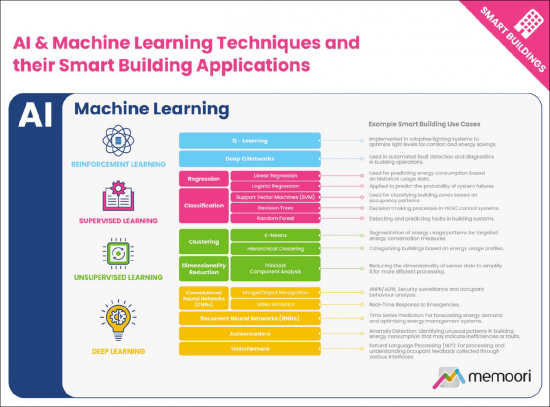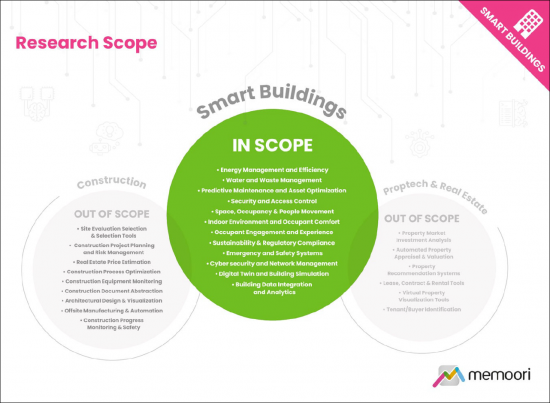 |
市場調查報告書
商品編碼
1448836
智慧商業建築人工智慧 (AI) 的全球市場:2024 年The Market for AI in Smart Commercial Buildings 2024 |
||||||
本報告是截至 2024 年的最新分析,探討了人工智慧 (AI) 在商業建築市場中日益增長的作用。
這項最新分析以Memoori 的2021 年人工智慧(AI) 市場分析為基礎,探討了AI 的整體功能和專業應用,以實現更智慧、更永續、反應更靈敏的建築環境。重點關注和分析兩者所發生的變化。
該報告是由兩部分組成的系列報告中的第一篇,關於人工智慧市場前景的第二部分預計將於今年稍後發佈。 這兩份報告均包含在我們的 2024 年Premium Subscription Service中,其中還包括對我們的ChatbotAIM的訪問,該服務利用大規模語言模型 (LLM) 來搜尋我們的所有分析報告。

本報告回答的關鍵問題
- 我們在 "真正的認知建設" 之路上處於什麼位置? 當今的商業建築技術正在從基於規則的分析過渡到人工智慧預測機器學習模型,但採用率仍然有限。實際實施的範圍仍然很窄,並且仍在能源優化、空間利用和安全等易於理解的領域內。
- 是什麼阻礙了人工智慧的廣泛採用?阻礙人工智慧廣泛採用的課題包括與遺留系統的技術整合、缺乏必要的專業技能和廣泛的教育,以及有效利用人工智慧解決方案所必需的新流程的緩慢採用。 。
- 商業建築人工智慧市場中期內將如何成長?智慧建築人工智慧市場預計到 2028 年將以 25.5% 的複合年增長率成長,達到 64.8 億美元。

這份報告以 164 頁的文字和 18 個圖表,提煉了所有重要事實並得出結論,讓您能夠準確地瞭解人工智慧技術如何以及為何應用於商業建築;
- 透過廣泛的分析,Memoori 將 66 個不同的人工智慧用例分為 12 個主要領域。在每個領域,智慧建築的解決方案都在積極開發和商業化。這些涵蓋了廣泛的潛在好處,從促進永續性和能源效率到增強安全性和客製化居住者體驗。
- 大型科技公司正在投入數億美元進行 "人工智慧軍備競賽" 。這正在推動快速創新,使每個行業受益。例如, ARK Invest 的研究表明,訓練深度學習模型的成本下降速度比摩爾定律快 50 倍。
- 由於人工智慧具有提高營運效率、改善住宅體驗和實現永續發展目標的潛力,商業建築業正處於重大進步的風口浪尖。隨著人工智慧技術變得越來越容易取得,商業房地產利害關係人必須策略性地駕馭這些發展,以充分利用人工智慧的潛力。
該報告提供了有價值的信息,可幫助公司改進戰略規劃,並考慮透過實施人工智慧技術來發展業務的潛力。
目錄
前言
調查範圍/方法
執行摘要
第 1 章人工智慧和機器學習的基礎知識
- 機器學習的基本方法
- 強化學習
- 監督學習
- 無監督學習
- 深度學習(深度學習)
- AI專業領域
- 計算機視覺
- 自然語言處理(NLP)
- 人工智慧世代
- 機器人技術
第 2 章 技術推動因素
- 物聯網(IoT)
- 大數據
- 人工智慧硬體和運算
- 人工智慧晶片
- AI邊緣設備
- 資料處理基礎設施
第3章 AI模型訓練與資料要求
- 培訓費用持續下降
- AI訓練目標與學習目標
- 數據要求
- 智慧建築中的遷移學習
第四章 市場現狀
- 炒作還是現實?
- 一般人工智慧介紹/投資趨勢
- 依行業劃分的採用率
- 地區差異
- 投資趨勢
- 投資報酬率(ROI)
- 企業情緒
- 主要用例和應用領域
- 智慧建築採用和投資的趨勢
- 招募指標
- 調查指標
- 智慧建築人工智慧解決方案成熟度評估
第五章:評估市場機會的規模
- 人工智慧市場預測的統合分析
- 評估人工智慧的好處
- 依地區劃分的市場分析
- 智慧建築市場預測
第六章 使用領域和用例
- 智慧建築用例:概述
- 將用例映射到資料輸入和人工智慧技術
- 智慧建築用例:市場評估
- 能源管理和效率
- 域概述
- 主要用例
- 水和污水管理
- 預測性維護/資產優化
- 安全和存取控制
- 空間/空缺/人員流動
- 室內環境/居住舒適度
- 居民參與度與體驗
- 永續性和法規遵從性
- 緊急/安全系統
- 網路安全/網路管理
- 數位孿生/建築模擬
- 數據整合/分析
第七章 市場課題與限制因素
- 基礎設施老化
- 用戶信任與信心
- 人工智慧高估與行銷
- 可解釋性
- 準確性和錯覺
- 數據相關的課題
- 整合、互通性和開放標準
- 資料所有權和控制權
- 數據品質
- 資料隱私
- 技能差距與人力資源開發
- 搬遷
- 人工智慧能耗
第 8 章 道德與監管考慮
- 人工智慧安全、道德和誠信
- 目前的人工智慧法規及其對智慧建築的影響
- 人工智慧法規與標準:世界各地的差異
- 資料隱私
- AI監理格局將如何演變?
第 9 章未來情境及其影響
- 通往AGI(通用人工智慧)之路:現狀
- 生成式人工智慧和互動式人工智慧的新應用領域
- 人工智慧代理
- AIaaS( "人工智慧即服務" )
- 可訪問性、民主化和開源人工智慧
This Report is a New 2024 Study that Explores the Growing Role of Artificial Intelligence within the Commercial Buildings Market.
This new research builds on Memoori's 2021 Artificial Intelligence (AI) market analysis and looks at the progress that has occurred both in the capabilities of AI broadly and its specialized applications enabling smarter, more sustainable, and more responsive built environments.
It includes, at no extra cost, a spreadsheet containing the data from the report and high-resolution presentation charts showing the key findings. It is the first in a 2-part series of reports, with the second report on the AI market landscape being published later this year. Both these reports are included in our 2024 Premium Subscription Service, which also gives access to our chatbot AIM, where you can query all our research using the power of Large Language Models (LLMs) .

KEY QUESTIONS ADDRESSED:
- Where are we on the journey towards "truly cognitive buildings"? Today's commercial buildings technology is transitioning away from rules-based analytics towards AI predictive machine learning models but adoption remains at modest levels. Real-world deployments remain narrow in scope driven by the more well-understood use cases around energy optimization, space utilization, and security.
- What is holding back more widespread adoption of AI? Challenges inhibiting widespread AI adoption span technical integration with legacy systems, a general lack of the necessary specialist skills and wider education, and a culture within commercial real estate that is slow to embrace the new processes essential to leveraging AI solutions effectively.
- How will AI in the Commercial Buildings Market Grow over the Medium Term? We estimate that the smart building AI market will grow at a 25.5% CAGR through 2028 to $6.48 billion, as this sector begins to embrace the emerging technology and closes the gap with more AI-centric industries.

WITHIN ITS 164 PAGES AND 18 CHARTS AND TABLES, THE REPORT FILTERS OUT ALL THE KEY FACTS AND DRAWS CONCLUSIONS, SO YOU CAN UNDERSTAND EXACTLY HOW AI TECHNOLOGY WILL BE APPLIED TO COMMERCIAL BUILDINGS AND WHY;
- Through extensive analysis, Memoori has mapped out 66 distinct AI use cases spanning 12 key domains where solutions are actively being developed and commercialized for smart buildings. These encompass a diverse range of potential benefits from driving sustainability and energy efficiency to security enhancements and more tailored occupant experiences.
- Billions of dollars are being invested by Big Tech in an "AI Arms Race". This is driving rapid innovation which will be of benefit to all industries. For example, Research from ARK Invest reveals that the cost of training deep learning models is decreasing at a rate 50 times faster than Moore's Law.
- The commercial buildings industry stands on the cusp of significant advancements, driven by AI's potential to enhance operational efficiencies, improve occupant experiences, and contribute to sustainability goals. As AI technologies become more accessible, commercial real estate stakeholders must navigate these developments strategically to harness AI's full potential.
This report provides valuable information to companies so they can improve their strategic planning exercises AND look at the potential for developing their business through implementing AI technology.
WHO SHOULD BUY THIS REPORT?
The information contained in this report will be of value to all those engaged in managing, operating and investing in Commercial Buildings (and their Advisers) around the world. In particular, those wishing to understand exactly how AI & Machine Learning Technologies are impacting Commercial Real Estate will find it particularly useful.
Table of Contents
Preface
Research Scope & Methodology
Executive Summary
1. The Fundamentals of AI & Machine Learning
- 1.1. Foundational Machine Learning Approaches
- Reinforcement Learning
- Supervised Learning
- Unsupervised Learning
- Deep Learning
- 1.2. Specialized AI Domains
- Computer Vision
- Natural Language Processing (NLP)
- Generative AI
- Robotics
2. Technology Enablers
- 2.1. The Internet of Things
- 2.2. Big Data
- 2.3. AI Hardware & Compute
- AI Chips
- AI Edge Devices
- Data Processing Infrastructure
3. AI Model Training & Data Requirements
- 3.1. Training Costs Continue to Fall
- 3.2. AI Training Goals and Learning Objectives
- 3.3. Data Requirements
- 3.4. Transfer Learning in Smart Buildings
4. The State of the Market
- 4.1. Hype or Reality?
- 4.2. General AI Adoption & Investment Trends
- Adoption Rates Across Industries
- Regional Variations
- Investment Trends
- Returns on Investment
- Corporate Sentiment
- Leading Use Cases and Applications
- 4.3. Smart Building Specific Adoption & Investment Trends
- Adoption Indicators
- Research Indicators
- 4.4. Assessing Smart Building AI Solution Maturity
5. Sizing the Opportunity
- 5.1. A Meta Analysis of AI Market Forecasts
- 5.2. Assessing the Gains Attributable to AI
- 5.3. Geographic Market Analysis
- 5.4. Smart Building Market Estimates
6. Applications & Use Cases
- 6.1. An Overview of Smart Building Use Cases
- Mapping Use Cases to Data Inputs & AI Techniques
- 6.2. Evaluating Smart Building Use Case Markets
- 6.3. Energy Management and Efficiency
- Domain Overview
- Key Use Cases
- 6.4. Water and Waste Management
- Domain Overview
- Key Use Cases
- 6.5. Predictive Maintenance and Asset Optimization
- Domain Overview
- Key Use Cases
- 6.6. Security and Access Control
- Domain Overview
- Key Use Cases
- 6.7. Space, Occupancy & People Movement
- Domain Overview
- Key Use Cases
- 6.8. Indoor Environment and Occupant Comfort
- Domain Overview
- Key Use Cases
- 6.9. Occupant Engagement and Experience
- Domain Overview
- Key Use Cases
- 6.10. Sustainability & Regulatory Compliance
- Domain Overview
- Key Use Cases
- 6.11. Emergency and Safety Systems
- Domain Overview
- Key Use Cases
- 6.12. Cybersecurity and Network Management
- Domain Overview
- Key Use Cases
- 6.13. Digital Twin and Building Simulation
- Domain Overview
- Key Use Cases
- 6.14. Data Integration and Analytics
- Domain Overview
- Key Use Cases
7. Challenges & Market Barriers
- 7.1. Legacy Infrastructure
- 7.2. User Confidence & Trust
- AI Overhype and Marketing
- Interpretability
- Accuracy & Hallucination
- 7.3. Data Related Challenges
- Integration, Interoperability & Open Standards
- Data Ownership & Control
- Data Quality
- Data Privacy
- 7.4. Skills Gaps and Workforce Development
- 7.5. Job Displacement
- 7.6. The Energy Consumption of AI
8. Ethical & Regulatory Considerations
- 8.1. AI Safety, Ethics & Alignment
- 8.2. The Current State AI Regulations & Implications for Smart Buildings
- Global Variations in AI Regulations & Standards
- Data Privacy
- 8.3. How the AI Regulatory Landscape Might Evolve
9. Future Scenarios & Their Implications
- 9.1. Where Are We on the Road to AGI?
- 9.2. Emerging Applications for Generative AI & Interactive AI
- 9.3. AI Agents
- 9.4. AI as a Service
- 9.5. Accessibility, Democratization & Open-Source AI
List of Charts and Figures
- Fig 1.0 - Research Scope
- Fig 1.1 - AI & Machine Learning Techniques and their Smart Building Applications
- Fig 2.1 - Installed Base of IoT Devices in Commercial Smart Buildings 2020 to 2028
- Fig 4.1 - Global Corporate Investment in AI by Type 2013 to 2022
- Fig 4.2 - AI Mentions in S&P 500 Earnings Calls Q3 2018 to Q3 2023
- Fig 4.3 - The Leading Applications for AI Deployments, % of Respondents
- Fig 4.4 - Real Estate Firm Engagement with AI Solutions in 2023
- Fig 4.4 - The Gap between Expected Impacts & Knowledge Levels for AI Real Estate
- Fig 4.5 - Trends in Smart Buildings & AI Research 2015 to 2023
- Fig 4.6 - Prescriptive Data's Model of AI Solution Maturity
- Fig 4.7 - Smart Building Solution Maturity
- Fig 5.1 - Global AI Market Forecasts, A Meta-Analysis 2019 to 2030
- Fig 5.2 - The Global Market for AI in Smart Commercial Buildings 2020 to 2028, $ Billions
- Fig 6.1 - AI & Machine Learning Use Cases in Smart Commercial Buildings
- Fig 6.2 - AI's Energy-saving Potential by Application Area, Energy Saving Effect %
- Fig 7.1 - Leading Barriers Hindering Enterprise AI Adoption %










